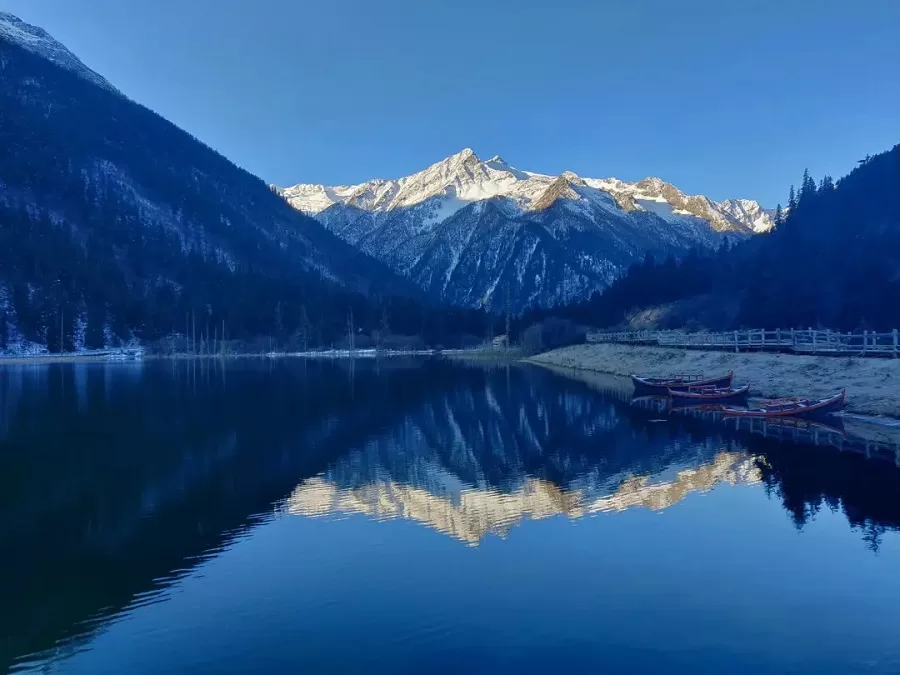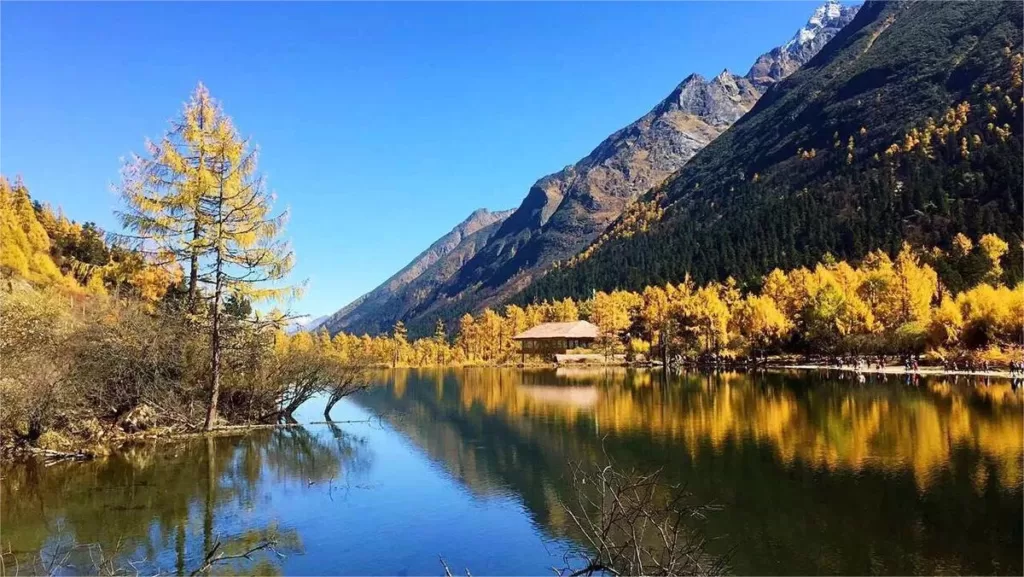Ледник Дагу, Сычуань - цена билета, часы работы, расположение и основные моменты


Dagu Glacier (达古冰川), situated in the Aba Tibetan and Qiang Autonomous Prefecture of Провинция Сычуань, is a modern mountain glacier with a name derived from its ancient origins (Dagu means reaching into the ancient history). Covering an area of 210 square kilometers, the scenic area also encompasses a natural reserve spanning 632 square kilometers. Within this region, 13 modern glaciers collectively cover an area of 6.04 square kilometers.
For centuries, Dagu Glacier remained a hidden gem, known only to the surrounding landscapes. It wasn’t until 1992 that Japanese scientists discovered Dagu Glacier through satellite observations. In August of the same year, scientists embarked on a week-long expedition to explore the glacier, deeming it the world’s lowest, largest in area, youngest in age, and closest to urban centers. Annually, from July to September, the Sichuan Mountaineering Association organizes large-scale mountaineering events in the region, drawing enthusiasts from all over.
Entering the scenic area, visitors can ascend the Blackwater River on eco-friendly sightseeing vehicles. Along the way, attractions like the Golden Monkey Lake, Red Army Lake, and Zena Lake, among others, dot the high-altitude landscape. At the Welcome Lake, a cable car provides direct access to the first glacier of Dagu Glacier, while Fairy Lake offers an excellent vantage point for observing the majestic Loga Snow Mountain in the distance.
Оглавление
- Основная информация
- Расположение и транспорт
- Highlights of Dagu Glacier
- Video about Dagu Glacier
- Полезные советы из подлинных отзывов
- Attractions near Dagu Glacier
Основная информация
| Сайт | https://www.dgbc.cn/ |
| Предполагаемая продолжительность тура | Около 3 часов |
| Цена билета | Admission: 120 RMB Admission + Shuttle Bus: 190 RMB Admission + Shuttle Bus + Cable Car: 370 RMB |
| Часы работы | 8.00 – 17.30; Last admission: 15.30 (1st May – 15th December) 8.30 – 17.30; Last admission: 15.00 (5th May – 31st December) |
| Номер телефона | 0086-0837-6729996 |
Расположение и транспорт
Located in the Aba Tibetan and Qiang Autonomous Prefecture, Dagu Glacier is surrounded by a breathtaking landscape characterized by rugged mountains, deep valleys, and lush forests. The region boasts a unique blend of alpine scenery and diverse ecosystems, making it a haven for nature lovers and adventure enthusiasts.
Dagu Glacier is about 300 kilometers to the northwest of Chengdu, the capital of Sichuan. The most convenient way to get there is to drive yourself, which also allows you to appreciate the marvelous scenery along the way.
Alternatively, you can first fly to Hongyuan Airport in Aba (阿坝红原机场) from Chengdu and then transfer to a coach to cover the remaining 98 kilometers.
Highlights of Dagu Glacier
Golden Monkey Lake

Every winter, the Golden Monkey Lake in Dagu Glacier becomes a temporary home for the Tibetan macaques, lingering for approximately five months. Known for their lack of fear towards humans, these macaques often form large groups along the roadside, seeking food from passersby. Upon entering the Dagu Glacier area, the first sight that greets visitors is the enchanting Gold Monkey Lake, surrounded by pristine mountain forests and crystal-clear waters. This scenic spot not only offers a glimpse into the unique ecological behaviors of the Tibetan macaques but also provides a serene and picturesque setting for visitors to appreciate the natural beauty of the Dagu Glacier region.
Dagu Lake

In Tibetan, “Da” translates to “glacier,” and “Gu” refers to a “deep ravine,” collectively meaning “glacier within a deep ravine.” Dagu Lake, formed by the melting waters of millennia-old glaciers, embodies the essence of its name. Nestled in the heart of this deep ravine, the lake showcases a mesmerizing spectrum of colors, transforming with the changing seasons. The waters of Dagu Lake, sourced from ancient glaciers, create a serene and ever-changing landscape, offering a visual symphony that evolves with the rhythms of nature. The lake stands as a testament to the dynamic beauty born from the intricate interplay between glacial forces and the passage of time.
Lingyun Waterfall

Lingyun Waterfall, cascading from the height of over 4300 meters at Yincuo Lake in Dagu Glacier, descends dramatically with a width of approximately 300 meters and a towering height of around 700 meters. Characterized by typical glacial erosion formations, it presents a breathtaking display of nature’s grandeur. During the summer, mist enshrouds the top of Lingyun Waterfall, creating an ethereal atmosphere. In winter, the waterfall transforms into a crystalline ice cascade, forming a majestic 3-meter-thick ice curtain that sparkles with transparency, adding to the enchantment of this remarkable natural spectacle.
Lovers’ Shoal

Lovers’ Shoal stands at the foot of Dagu Glacier, surrounded by verdant mountains, making it a romantic haven beneath the glacier. Originally a meeting place for Tibetan people seeking love, it is where young men and women expressed their affections, ultimately holding hands at the Lovers’ Shoal. Located in the pristine shadow of the snow-capped mountains, it symbolizes the pure and unblemished nature of lovers’ affection. Positioned at the perennially frozen base of the glacier, it represents the enduring and timeless quality of love. Lovers’ Shoal is a sacred spot where the natural beauty of Dagu Glacier blends seamlessly with the tender narratives of human emotions and connections.
Luogesi (Guardian Deity of the Mountains)

Luogesi, meaning “the guardian deity of the mountains” in Tibetan, is a sacred mountain in the Dagu Glacier region. Luogesi is a leisure and scenic area that seamlessly blends high mountain meadows, snow peaks, and waterfalls. The gorge is abundant in water, with a mild climate and well-covered forest vegetation. There are 21 waterfalls and streams of various sizes within the area. Apart from its natural beauty, Luogesi holds cultural significance as a pilgrimage site for the Tibetan people. Every May and September, villagers engage in the ritual of circumambulating the mountain, seeking blessings and performing sacred activities.
Annually, the local Tibetan community gathers at Luogesi for prayer and rituals, including the tossing of prayer flags, chanting scriptures, and traditional dances, aiming to invoke blessings from the sacred mountain. This pilgrimage route is revered as the “Path of Pilgrimage,” where locals express their devout prayers, hoping for auspiciousness and favorable weather in the coming year.
Video about Dagu Glacier
Полезные советы из подлинных отзывов
Timing of Visit: It is advisable to visit Dagu Glacier when there is sufficient snow accumulation. Otherwise, the site may appear to be mostly rocks with scattered snow patches.
Terrain and Weather Precautions: The snow-covered ground tends to be icy, and the wind can be strong. Wear shoes with good traction to prevent slipping. Due to the intense wind, protect yourself from the cold by dressing warmly. Windproof and insulated clothing, along with accessories like gloves and a hat, are recommended. Be prepared for the harsh conditions, and take preventive measures against high-altitude reactions.
Extreme Cold Conditions: Expect extremely cold temperatures at higher altitudes. The wind chill factor can make it feel even colder than the actual temperature. Dress in layers to stay warm.
Interaction with Locals: The local Tibetan people are generally hospitable and friendly. However, always seek permission before taking photographs of them.
Wildlife Caution: Monkeys are present at the lower elevations. Avoid carrying handbags or bags that may attract monkeys, as they can be bold in attempting to snatch items.
Accommodation Considerations: Accommodations in the Tibetan area may have limited facilities and hot water availability. It is advisable to bring your own toiletries, sleepwear, toothbrush, toothpaste, and slippers.
Attractions near Dagu Glacier

Ущелье Бипенг

Деревня Таопин Цян

Долина реки Мэнтун
Достопримечательности в Абе, Пейзажи Сычуани, Тибетская область Сычуань